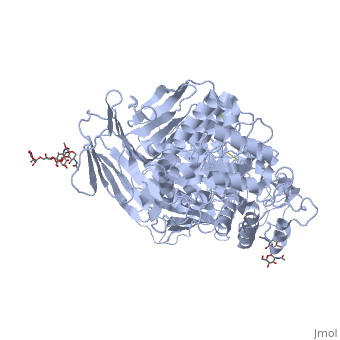3lpo
From Proteopedia
Crystal structure of the N-terminal domain of sucrase-isomaltase
Structural highlights
DiseaseSUIS_HUMAN Congenital sucrase-isomaltase deficiency. Defects in SI are the cause of congenital sucrase-isomaltase deficiency (CSID) [MIM:222900; also known as disaccharide intolerance I. CSID is an autosomal recessive intestinal disorder that is clinically characterized by fermentative diarrhea, abdominal pain, and cramps upon ingestion of sugar. The symptoms are the consequence of absent or drastically reduced enzymatic activities of sucrase and isomaltase. The prevalence of CSID is 0.02 % in individuals of European descent and appears to be much higher in Greenland, Alaskan, and Canadian native people. CSID arises due to post-translational perturbations in the intracellular transport, polarized sorting, aberrant processing, and defective function of SI.[1] [2] [3] [4] [5] FunctionSUIS_HUMAN Plays an important role in the final stage of carbohydrate digestion. Isomaltase activity is specific for both alpha-1,4- and alpha-1,6-oligosaccharides.[6] Evolutionary ConservationCheck, as determined by ConSurfDB. You may read the explanation of the method and the full data available from ConSurf. Publication Abstract from PubMedHuman maltase-glucoamylase (MGAM) and sucrase-isomaltase (SI) are small intestinal enzymes that work concurrently to hydrolyze the mixture of linear alpha-1,4- and branched alpha-1,6-oligosaccharide substrates that typically make up terminal starch digestion products. MGAM and SI are each composed of duplicated catalytic domains, N- and C-terminal, which display overlapping substrate specificities. The N-terminal catalytic domain of human MGAM (ntMGAM) has a preference for short linear alpha-1,4-oligosaccharides, whereas N-terminal SI (ntSI) has a broader specificity for both alpha-1,4- and alpha-1,6-oligosaccharides. Here we present the crystal structure of the human ntSI, in apo form to 3.2 A and in complex with the inhibitor kotalanol to 2.15 A resolution. Structural comparison with the previously solved structure of ntMGAM reveals key active site differences in ntSI, including a narrow hydrophobic +1 subsite, which may account for its additional substrate specificity for alpha-1,6 substrates. Structural basis for substrate selectivity in human maltase-glucoamylase and sucrase-isomaltase N-terminal domains.,Sim L, Willemsma C, Mohan S, Naim HY, Pinto BM, Rose DR J Biol Chem. 2010 Jun 4;285(23):17763-70. Epub 2010 Mar 31. PMID:20356844[7] From MEDLINE®/PubMed®, a database of the U.S. National Library of Medicine. See AlsoReferences
| ||||||||||||||||||||


